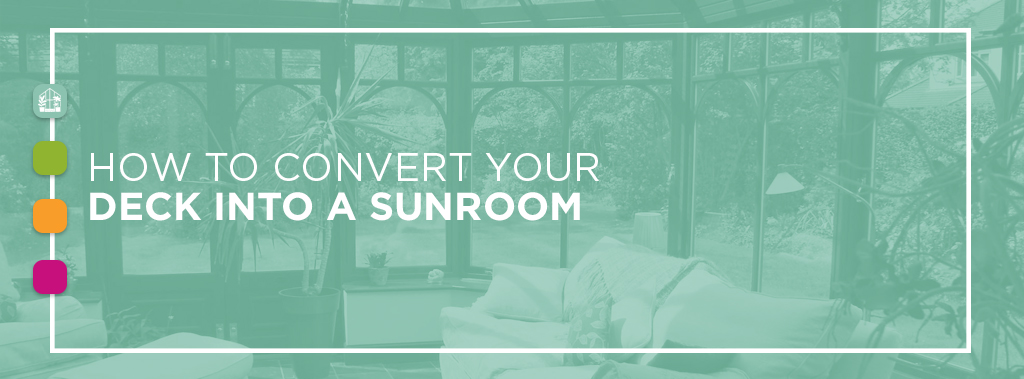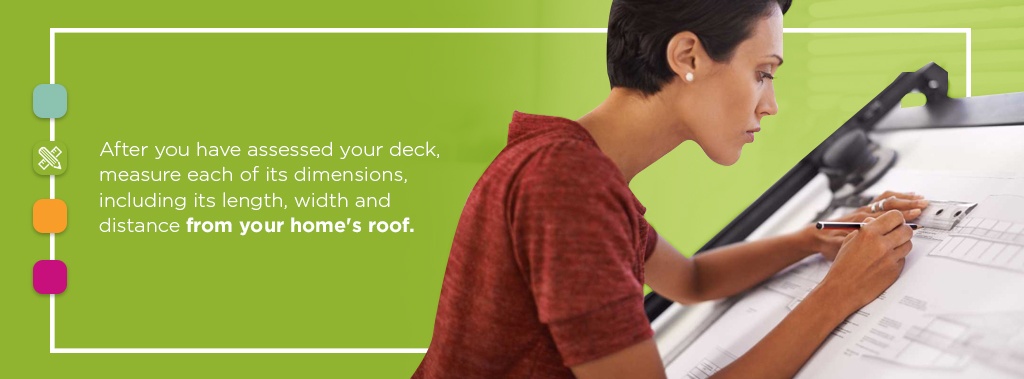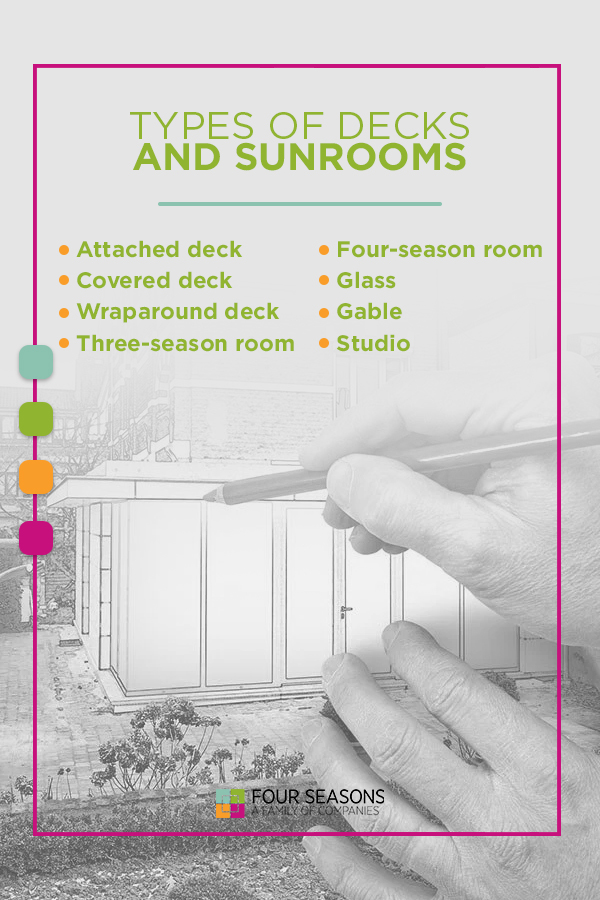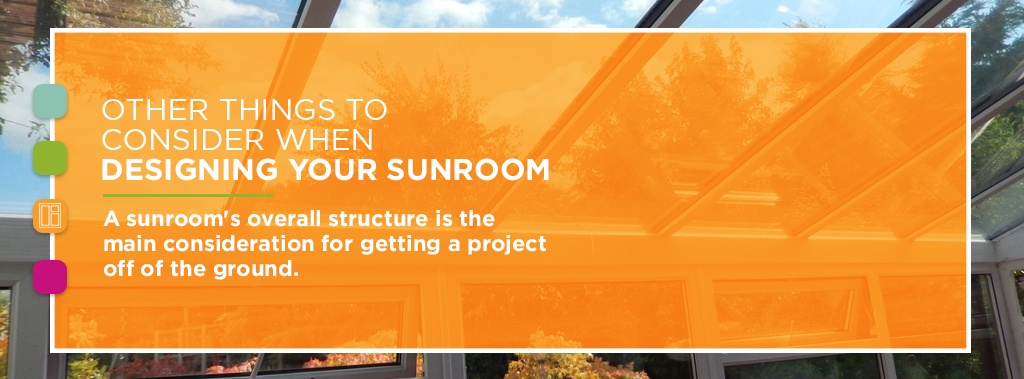Imagine stepping into a sun-drenched space you can enjoy year-round. Maybe you’ve filled it with plants, or perhaps it has a table and chairs for entertaining. Sunrooms are versatile, inviting places that add a warm touch to your home.
Some sunrooms are an original feature, while others are a later addition. If you have an outdoor deck, you have a perfect place to create this gorgeous space. Ready to get started? From the planning and design stage to hiring a contractor, learn the ins and outs of converting your deck into a sunroom.

The Pros and Cons of Converting Your Deck into a Sunroom
The idea of a sunroom is beautiful, but like any home renovation project, you will want to weigh the pros and cons before diving in feet first. Here are the major considerations homeowners should understand before embarking on a deck to sunroom conversion.
Pros
Pros of adding a sunroom to your home include:
- Year-round use: A deck is a lovely place to enjoy the outdoors during the warmer months, but that space will go unused during any inclement weather. When you convert your outdoor area into an indoor sunroom, you can use it all year round. Instead of snatching glimpses of the outdoors from your windows, you can settle down in the sunroom anytime and enjoy your landscape view.
- Increased home value: A sunroom, like many other home improvement projects, has short-term and long-term benefits. You can enjoy the project as soon as you’ve completed it. Your sunroom can also increase your home’s value in the long term. Sunrooms can enhance the curb appeal of a home and attract future buyers.
- Energy efficiency: It’s possible to design and build a sunroom with energy efficiency in mind. The right windows and insulation can help you save energy in your home.
- Natural light: As the name suggests, sunrooms get plenty of natural light. You can enjoy hours of sunshine in the comfort of your home.
Cons
However, you should also consider the following factors before you start gathering your supplies:
- Cost: A sunroom may be an enjoyable addition to your home and an investment in future home value, but it does involve upfront cost. While the price may concern some homeowners, sunroom projects come in a wide variety of configurations that can work with nearly any budget. When thinking about adding a sunroom, consider how often you will use the room and how it could affect your home’s future value.
- Privacy: Sunrooms are typically made with large panes of glass, which allow natural light into the room. While this setup allows people in the home to enjoy an expansive view, it also may bring up privacy concerns. If you are worried about nearby neighbors or passersby, curtains or shades can be a helpful addition. With Conservaglass™ Windows have an unobstructed view looking out and coatings give privacy looking into the windows from outside.
- Change: Some homeowners may fear commitment to such a big project. Will you miss the deck? Will you like how the finished sunroom looks? Take time to think through these questions to ensure your happiness with your new home addition.
Learn More About Our Product Offerings
Assessing the Deck
The first step in planning out how to build a sunroom on a deck is evaluating the space you will convert. Use this simple deck inspection checklist:
- Attachment style: How is the deck attached to your home, if at all? Are any fasteners securely in place?
- Foundation: Does the deck have a foundation? If not, you will likely need to build one for the sunroom.
- Materials: What is the deck made of? What condition is its material? Can you incorporate any of that material into the new sunroom?

After you have assessed your deck, measure each of its dimensions, including its length, width and distance from your home’s roof. This information will help determine the size and style of sunroom your home can accommodate. Our Design Consultant will also assess and measurement the space on your appointment. Once the contract is signed, the Project Manager also performs an in depth assessment to take to the Architect.
How to Get a Building Permit for Your New Home Addition
When are building permits required for remodeling? Your area’s local building codes will dictate the answer. A sunroom involves a structural change to your home, which will almost certainly require a permit. Do your homework and check with your local municipality.
The process of obtaining a building permit for a home addition depends on local ordinances. In most cases, you’ll need to fill out an application with the city or county. The local authority may conduct an on-site visit before granting the permit. The project may also be subject to final approval from the local jurisdiction. Maryland Sunrooms also checks and pulls all necessary permits and ordinances, we even help with HOA’s if applicable.
Designing and Building the Room
Design ideas for your deck conversion are limited only to your imagination. Think about the aesthetic you want from the final project and how you will use the room. Do you like the all-glass look, or do you prefer the classic feel of screen paneling? Refer to your deck measurements when you picture the size and shape of the sunroom.
It is possible to obtain the building permit, purchase the materials and build the sunroom on your own. If you have the necessary skills, this ambitious DIY project can feel quite rewarding.
If you need help with the design and building process, a sunroom installation contractor can help translate your vision to paper, assist with permit requirements and handle the construction process.
Types of Decks and Sunrooms

Decks come in a variety of different styles. Here are a few of the common deck types that a contractor can transform into a gorgeous sunroom:
- Attached deck: Attached decks are one of the most popular designs for sunroom conversion. This deck is typically slightly elevated and attached to the back or side of a home. It may have steps leading into the yard. A contractor can help you to determine how to install a sunroom on a raised deck.
- Covered deck: A covered deck can also be attached to a home. This style has a partial or total covering, which offers more shade and shelter from the elements.
- Wraparound deck: Wraparound decks are typically elevated, situated at the same level as the entrance of the home. This type of deck may be uncovered or covered. The deck may wrap around the front and one side of the home or around the entire first floor.
Once you decide to convert your deck, you will have several different sunroom styles to consider:
- Three-season room: A three-season room is one of the most common types of sunrooms. Contractors design these rooms for use for most of the year, save for its coldest months. When determining how to build a 3 season room on a deck, keep in mind that they do not have much insulation. The door from the sunroom to the home is usually an entry-way style door with more insulation to prevent cold from seeping indoors during winter.
- Four-season room: Four-season rooms are designed for year-round use. When looking at how to build a four-season room on a deck, they usually feature energy-efficient glass, more insulation, and heating and cooling provided by an HVAC system. Since this type of sunroom is insulated like the rest of the home, it can have an indoor-style door separating it from the house.
- Glass: Cover your sunroom in glass paneling and roofing. This type of sunroom is made with glass walls and a roof made of either segmented glass or polycarbonate. This style is popular for growing indoor plants.
- Gable: A gable sunroom is defined by the structure of its roof. It will have two roof panels with a support beam, and its walls can be made of glass or screen paneling.
- Studio: A studio sunroom, also called a shed, can also have glass or screen walls. This sunroom’s single-pitch roof slopes away from the home.
How do you decide what type of sunroom is right for your deck? First, consider how often you want to use the room. If you envision it being a cozy spot for year-long enjoyment, opt for a four-season room. If you think you would use it most during nice weather, a three-season room is a good fit.
Afterward, consider the structure of your existing home. Will enclosing the deck be a simple process, or are existing features in the way? Where is your home’s roofline? A contractor can help you determine which style will best fit your home’s structure.
Learn More About Our Product Offerings
Other Things to Consider When Designing Your Sunroom

A sunroom’s overall structure is the main consideration for getting a project off of the ground. However, it is not the only component of the finished room. You will also need to consider:
- Flooring: Just like any interior room, your sunroom will need to be floored. You can decide what flooring works best based on your sunroom’s intended use. Hardwood floors, tile and carpeting are all options to consider.
- Furniture: After all the work put into the sunroom, you want to decorate and use it to its fullest extent. Consider what kind of furniture you want to fill the space. Do you want couches and chairs for relaxing? Would you enjoy shelves for all of your plants and books? Or, do you imagine a dining table for hosting parties?
- Window treatments: While sunrooms are designed to allow light indoors, that doesn’t mean you want to forget window treatments. Consider blinds and curtains to manage the amount of light coming inside and create a more enclosed space if you’d like some extra privacy.
How Much Does It Cost to Convert a Deck Into a Sunroom?
From Pergolas to all glass Sunrooms, projects can vary greatly in cost, starting as low as $12,000 and going as high as $100,000. The cost will depend on the sunroom’s style and intended use. For example, a three-season room will be less expensive because it does not require as much insulation as it would take to turn a deck into a four-season room.
No matter the price point, homeowners have several options available to them to finance a deck conversion. First, talk to your contractor. Many builders have financing programs available. Homeowners can also pursue a home improvement or home equity loan. Some can even finance the project using a credit card or Mortgage Equity Loans.
Hiring a Sunroom Contractor
Choosing a contractor is the final step in kicking off your conversion project. Your contractor will take your vision to reality, so you need to do your homework to find the right fit. Here are several important questions to ask when hiring a contractor:
- How much will the project cost? Before you dive into specifics, always get a cost estimate from potential contractors. You need to know that their work is within your budget.
- How long will the project take? Home additions mean noise and crews of workers at your home for hours at a time. You will want to know what to expect in terms of a timeline. How long will the contractor and crew be at your home each day?
- Will you obtain the necessary permits? Contractors in your area will know local permit requirements. Ask if securing the proper authorizations is part of the service the contractor offers.
- Can I see examples of your other work? When you commit to a sunroom conversion, you want to know the finished product will be functional and aesthetically pleasing. Ask potential contractors to display their experience. Look at past project examples to see if you like their work.
- Are you licensed and insured? Contractors need to be licensed and insured to protect their workers, the people who live in your home and your property. Ask for a copy of their General Liability Certificate.
- Read Online Reviews – Well respected companies will have many reviews from happy customers and most definitely will have reviews if they have UNHAPPY customers, its best to hear straight from the customers themselves to get insight into the experience, response time and workmanship that you can except from the contracting company.
Sunrooms for the Mt. Airy Region

A sunroom can be a beautiful addition to your home, so you want to know that the project is in the right hands. Maryland Sunrooms, serving the Mt. Airy region, has more than 100 years of combined experience in designing and installing sunrooms. We are a Guild Quality member and a member of the National Sunroom Association.
When you are ready to upgrade your home, we have the necessary expertise for turning a deck into the sunroom of your dreams. Book an appointment with Maryland Sunrooms to get the project started.

Julie Shetter is the Marketing Director at Maryland Sunrooms. She has over a decade of experience in the home improvement and sunroom industry.

